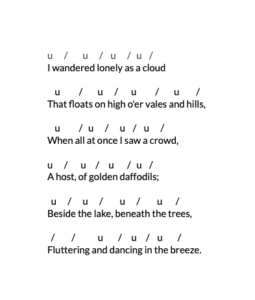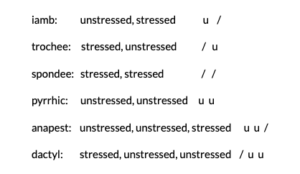How to scan a poem, and why scansion is important?
You know that Shakespeare and Yeats wrote in iambic pentameter, and maybe you have a vague memory of scanning a poem in high school English. But you’re not sure if meter is relevant to contemporary poetry. Tell Tell Poetry knows it is! But to use scansion effectively in your own work, first you have to know what it is and how to do it.
What is scansion, and why use it?
Scansion is the act of scanning a poem for meter, or marking each syllable and each line in a poem to notice where the stressed and unstressed syllables fall in a line of poetry. The rhythm in a poem is made up of stressed and unstressed syllables—syllables with greater or lesser natural emphasis—and this is formally called meter. Careful attention to meter allows a poet to develop a deeper sense of a poem’s musicality. Scanning a poem allows us to visually see how the meter operates in a poem, and it allows us to notice patterns and changes in emphasis.
Careful attention to stressed and unstressed syllables also allows a poet to develop a deeper sense of a poem’s musicality and rhythm. Meter is the natural rhythm of speech and language, and while many of us have a natural or instinctive sense of musicality in poetry, learning how to recognize and talk about meter can help take that instinct and strengthen it. Scansion, or the ability to scan a poem, is one tool available to help poets better understand their own poetry and the poetry they encounter.
Delight in stressed and unstressed syllables is inherent to English-language speakers. Children’s nursery rhymes rely heavily on regular meter (and sometimes, on changes in meter) to create delight, surprise, and to underscore the meaning of the rhyme. Take a moment and try singing “Hickory Dickory Dock” or “Hey Diddle Diddle” out loud, and notice how the rhythm of the rhyme propels it forward—this is meter in action!
All right, so how do I scan a poem?
To scan a poem, you first have to know how to identify stressed and unstressed syllables in a word or phrase. A stressed syllable has more natural emphasis; an unstressed syllable is not emphasized. Let’s start with a single word. Try saying the word “everybody” out loud.
EV ry BO dy
You might notice that you put more emphasis, or stress, on the first and second syllables. These are called stressed syllables, and when we are noting meter, we note stressed syllables with a / mark.
The second and fourth syllables are not emphasized; they are unstressed syllables. We note unstressed syllables with a u mark.
If we wanted to scan the word “everybody,” it would look like this:

Notice how the stressed / and unstressed u markings go above the syllable to show where the natural emphasis occurs in the word.
To practice getting attuned to meter, you might find it helpful to try clapping the syllables of a word or line while you read it out loud. Clap loudly for the stressed syllables, and clap softly or just barely touch your hands together for the unstressed syllables.
Now, we can use this same technique to scan (or mark the stressed and unstressed syllables) for a whole line of poetry.

Let’s take a look at what the first stanza of William Wordsworth’s “I Wandered Lonely as a Cloud” would look like. You can listen to the poem read out loud, which will help you see the relationship between scansion and meter, or rhythm.

In this stanza, it’s easy to see that Wordsworth uses a regular, rhythmic meter, which creates a pleasing musical tone for this poem.
Practice makes perfect
Poet Annie Finch, Queen of Meter, workshop leader, and author of several books of poetry and craft, has helpful tools available on her website to help you practice and master poetry scansion. This video is our favorite! Make sure to check out our interview with Annie and hear her talk about why meter and scansion is so important. Also, this website allows you to practice scansion, and this website has more practice examples.
Just for fun,
you might like knowing what different meter rhythms are called.
A unit of stressed and unstressed syllables is called a foot; a foot consists of 2 or 3 syllables. Here are common feet in the English language:

Once you’re comfortable with scanning poems, we’re ready to talk about how scansion can help you strengthen your own work. See Part 2 of our scansion conversation to deep-dive into how to make this poetic tool work for you.





Comments (0)